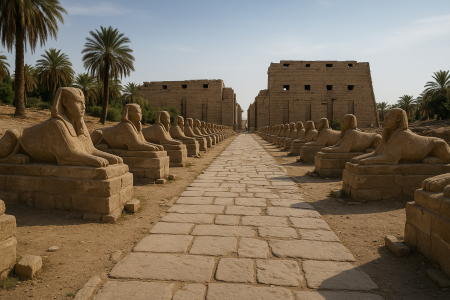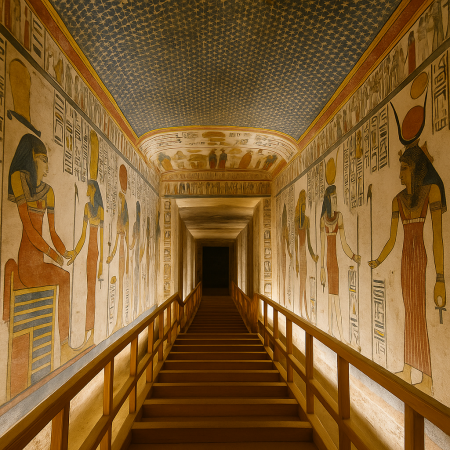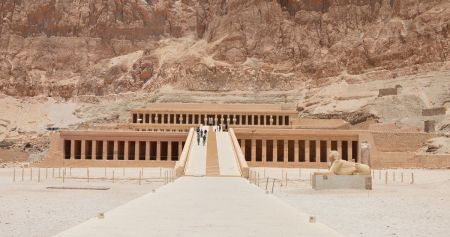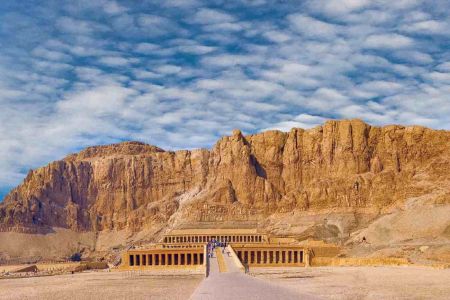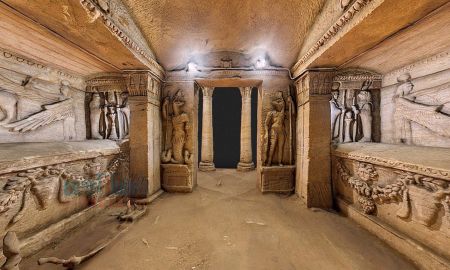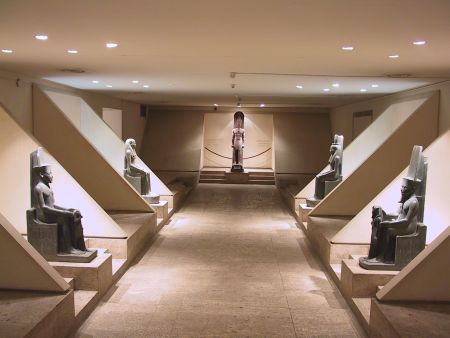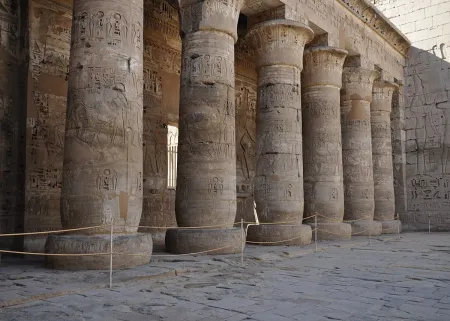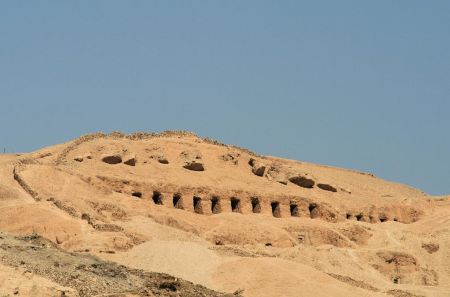Dendera Temple Complex : The Celestial Sanctuary of Hathor in Upper Egypt

Introduction to Dendera Temple: An Egyptian Masterpiece Off the Beaten Path
Hidden in the quiet town of Dendera near Qena, just north of Luxor, the Temple of Hathor at Dendera stands as one of Egypt’s best-preserved and most underrated ancient temples. Dedicated to Hathor, the goddess of love, beauty, joy, music, fertility, and motherhood, this majestic complex invites travelers into a mystical realm of astronomical ceilings, underground crypts, secret staircases, and captivating reliefs.
Unlike the more crowded temples in Luxor or Aswan, Dendera Temple offers a more personal, atmospheric experience. Its sandstone walls still echo with the sacred rituals of pharaohs and priests who worshipped Hathor as a motherly protector and celestial healer. Featuring some of the most detailed carvings and vibrant paintwork in Egypt, the temple is a visual feast and a spiritual marvel.
This is not just a monument to gods—it’s a fusion of mythology, science, and art, showcasing Egypt’s deep connection between sky and earth. From the famous Dendera Zodiac to the cryptic light bulb reliefs and astronomical ceiling charts, the Dendera Temple Complex offers rare insight into the mind of ancient Egyptian thinkers and priests.
Historical Background of the Temple of Hathor at Dendera
Origins and Construction
The Temple of Hathor that visitors see today dates mainly to the Ptolemaic and Roman periods, between 54 BCE and 20 CE. However, Dendera’s sacred status predates this structure by thousands of years. Archaeological evidence points to religious activity at the site since the Old Kingdom, particularly during the 6th Dynasty (c. 2345–2181 BCE).
Successive rulers, including Ptolemy XII Auletes (Cleopatra’s father) and Roman Emperor Tiberius, contributed to the temple’s construction. Though it was built late in Egypt’s ancient timeline, it strictly adhered to traditional Pharaonic architecture and spiritual symbolism.
Importance of Hathor in Egyptian Mythology
Hathor was more than a fertility goddess—she was a cosmic force, often depicted as a woman with cow ears or a sun disk with cow horns. She represented joy, love, motherhood, and the afterlife. At Dendera, she was believed to protect the living and guide the souls of the dead to rebirth. As the consort of Horus, Hathor played a key role in temple rituals and royal legitimacy.
Architectural Highlights of the Dendera Temple Complex
Grand Hypostyle Hall
Upon entering the temple, visitors are immediately awed by the Hypostyle Hall, with its 24 massive Hathor-headed columns rising toward a ceiling adorned with astronomical scenes. The colors—blues, golds, reds—have survived for over two millennia. These vivid images show the daily solar cycle, lunar phases, and celestial deities guiding the cosmic order.
Ceiling Astronomical Charts
Among the ceiling reliefs are unique astronomical maps, including constellations and depictions of the sky goddess Nut, stretching across the heavens. These carvings reflect the Egyptians’ sophisticated understanding of astronomy and timekeeping.
The Dendera Zodiac
One of the temple’s most intriguing features is the Dendera Zodiac, a circular bas-relief that once adorned the ceiling of a chapel dedicated to Osiris. It depicts the 12 zodiac signs, planetary deities, and celestial alignments, blending Egyptian and Greco-Roman astronomical knowledge.
Today, the original zodiac resides in the Louvre Museum in Paris, but a replica is on display at Dendera. Scholars continue to debate whether this ancient map served religious, agricultural, or astrological purposes—or all three.
Secret Crypts and “Light Bulb” Reliefs
Hidden beneath the temple floor are underground crypts, accessible by narrow staircases. Inside, strange reliefs depict a lotus flower emitting a bulb-shaped object supported by a serpent—commonly dubbed the Dendera Light Bulb. Some alternative theorists suggest these represent ancient electrical knowledge, though mainstream Egyptologists interpret them as symbolic religious imagery tied to creation myths.
Rooftop Sanctuaries and Ritual Chambers
Dendera is one of the few temples in Egypt where visitors can climb to the roof. Up there, you’ll find open chapels used for New Year and solar rituals, particularly honoring the rebirth of the sun. Processions involving the golden statue of Hathor would ascend to the roof, symbolizing her reunion with the sun god.
The spiral staircases leading to the roof are elaborately decorated with scenes of priests, incense, and sacred offerings—every step a part of ritual life.
Other Structures Within the Dendera Complex
The Dendera Temple Complex includes more than just Hathor’s temple:
-
Sanatorium: Where healing rituals were performed with sacred water
-
Sacred Lake: Used for purification rites by priests
-
Birth House (Mammisi): Dedicated to the divine birth of Horus, with vibrant scenes of motherhood
-
Christian Basilica: Evidence of Dendera’s later occupation during the Coptic Christian period
-
Temple of Isis and other chapels honoring various deities
These structures form a sacred landscape that reflects thousands of years of religious evolution.
Visiting Dendera Today
How to Get There
-
Location: About 60 km (37 miles) north of Luxor and 5 km from Qena
-
Access: By private car, organized tours from Luxor, or Nile cruise extensions
-
Travel Time: Around 1.5 hours from Luxor by road
Best Time to Visit
The ideal time to visit is October to April, when Egypt’s weather is milder. Early morning or late afternoon visits offer better light for photography and a quieter atmosphere.
Entrance Fees and Tickets
As of 2025:
-
General admission: Approx. 200 EGP (subject to change)
-
Includes access to rooftop, crypts, and main temple areas
-
Guided tours are available on-site or pre-arranged from Luxor
Tips for Visitors
-
Bring a flashlight to explore dark crypts
-
Wear comfortable shoes for stair climbing
-
Don’t miss the rooftop views—sunsets are especially magical
-
Hire a guide for rich interpretations of symbolic artwork
-
Combine with a visit to Abydos Temple for a full-day ancient Egypt tour
Dendera Temple in Modern Culture and Studies
Archaeological and Scientific Interest
The vivid colors and intact structures have drawn ongoing archaeological interest. Egyptologists study the temple for insights into late Egyptian theology, astronomical beliefs, and religious continuity during Ptolemaic rule.
Symbolism in Pop Culture and Theories
The Dendera Light Bulb has fueled alternative history theories and even appeared in documentaries and fiction. While the mainstream view remains that it’s mythological symbolism, the debate keeps the temple alive in public imagination.
FAQs About Dendera Temple
What is the Dendera Temple famous for?
It’s renowned for its well-preserved astronomical ceiling, the Dendera Zodiac, underground crypts, rooftop sanctuaries, and stunning Hathor-head columns.
Who built the Temple of Hathor at Dendera?
Mainly constructed during the Ptolemaic and Roman periods, with contributions from rulers like Ptolemy XII, Cleopatra VII, and Tiberius.
What is the Dendera Light Bulb?
A mysterious relief in the crypts showing a bulb-shaped object—widely debated between symbolic and pseudo-scientific interpretations.
Can you visit the temple rooftop and crypts?
Yes, visitors can climb the decorated staircases to the roof and explore the underground chambers—rare features in Egyptian temples.
How does Dendera compare to Luxor or Karnak temples?
Dendera is smaller but far better preserved. It offers more colorful reliefs and a deeper spiritual intimacy, especially without large tourist crowds.
Final Thoughts: Why the Dendera Temple Is a Hidden Gem of Egypt
The Dendera Temple Complex is a forgotten jewel that merges myth, astronomy, healing, and beauty into a single monumental experience. Its vibrant columns, cosmic ceilings, and underground secrets tell stories of gods and stars, music and motherhood, science and symbolism. For anyone seeking a unique window into ancient Egypt’s spiritual heart, Dendera isn’t just a detour—it’s a celestial destination worth the journey.


